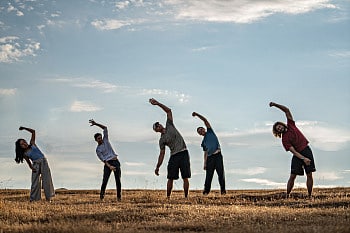What Is Health?
Paramhansa Yogananda said that the root cause of illness is the conflict between the soul and the ego: the soul trying to draw us toward an awareness of our unity with God, and the ego trying to convince us that we are separate individuals.
The subconscious tension created by this opposition produces blockages in the flow of life force, and ultimately, disease. Good health results from a strong unobstructed flow of life force to all areas of the body; while illness, moods, apathy — in fact, all negative states — are symptoms of a conflict or blockage of the life force.
Health does not mean mere existence. Keeping out of the hospital is not health. To be able to resist disease, to bear strain, to stimulate mental vitality, and to feel the body as a luxury – as a bird feels when shooting through the air, and as a child does always – is health. -Paramhansa Yogananda
One of the great benefits of meditation is gradual freedom from these conflicts as we achieve integration in our consciousness. We are then free to experience our natural state of vibrant health and energy.
This is not to say that there are no physical causes for disease, for certainly there are. Rather, we should recognize that physical symptoms usually have their root cause in consciousness or habit patterns. Basically, there are four aspects of health: physical, energetic, mental/emotional, and spiritual.
What Are the Four Aspects of Health?
Physical
Energetical
Mental
Spiritual
The four aspects of health are physical, energetic, mental/emotional, and spiritual. These aspects range from the dense physical level to the subtle spiritual level. We have the ability to positively and constructively impact our health and well-being holistically by learning how to properly use our Life Energy and Will Power.
First Aspect of Health: Physical Health
 There are four aspects of health that we want to address here but on the physical level, there are three areas that can, when properly controlled, bring the system back into a state of balance. These are proper diet, proper exercise, and toxin-free living. By bringing these three areas into balance, we can greatly affect our health, longevity, and quality of life.
There are four aspects of health that we want to address here but on the physical level, there are three areas that can, when properly controlled, bring the system back into a state of balance. These are proper diet, proper exercise, and toxin-free living. By bringing these three areas into balance, we can greatly affect our health, longevity, and quality of life.
There is an enormous amount of material available about physical health that is identified as not only an important goal but a national obsession as well. Yet, the basic principles are both very simple and very powerful.
For most people, a diet composed mainly of fresh vegetables, fruits, and natural grains, with some legumes, nuts, and milk products will provide optimum nutritional benefits.
A vegetarian diet is best but if meat is eaten, it should be used sparingly and consist primarily of fish or fowl. Keep away from sugar and overly processed food, and avoid overeating. Fasting one day each week is one of the best and easiest ways to maintain a healthy body. Do not become fanatical — balance your diet and then forget it.
A simple exercise routine will pay back many times its cost in time and effort. Try to exercise for at least 30 minutes per day. Any exercise that makes you breathe hard will be enormously helpful. Aerobic exercise unleashes a process of better circulation, cellular cleansing, weight control, and glandular rebalancing, which helps on both physical and mental levels.
For most, the best basic exercise is simply walking. But anything you enjoy is the best choice for you. Yoga postures are not only a good physical exercise but have the added benefits of giving improved flexibility and balancing your life force. Some weight-bearing or isometric exercise is also important, especially for bone density. This is another good reason to learn and practice the Energization Exercises, a sequence of exercises created by Paramhansa Yogananda mainly consisting of tensing and relaxing different muscles.
Finally, on a physical level, avoid introducing toxins into your system. The three worst habits and best to eliminate are the use of cigarettes, alcohol, and drugs. Any of these will not only take years off your life but will also greatly reduce your quality of life.
There is so much information available about this subject that virtually everyone knows at least four aspects of health but the three habits above are consistently known to be self-destructive. It is not easy to overcome them but meditation can be a great aid in making healthy lifestyle changes.
Second Aspect of Health: Energetic Health
 On the second level of energy, we must recognize the importance of prana, or life-force. Our health is good when our life-force is balanced and strong, but illness results if it is weak, out of balance, or blocked.
On the second level of energy, we must recognize the importance of prana, or life-force. Our health is good when our life-force is balanced and strong, but illness results if it is weak, out of balance, or blocked.
Many Oriental disciplines such as Ayurveda and acupuncture work with these subtle currents. The flow of prana can be increased by certain techniques that help us consciously enhance and direct these currents in the body.
Man does not live by bread alone. Yogananda emphasizes in his work and teaching that the body cannot be solely sustained by food and sunshine. He demonstrated that we have access to an infinite source of energy. That energy—Cosmic Energy—is a perpetual source of vitality and rejuvenation. It is in and all around us and we can call upon it and use it to build, strengthen, and heal the physical body. In essence, the food we eat and the sunshine we enjoy so much also have to be converted into energy before the physical body can effectively make use of them.
Yogananda’s Energization Exercises help bring the flow of prana under our conscious control and send it to various parts of the body to revitalize them.
A second factor is our willingness on conscious or subconscious levels, which acts as a master switch. Energy is blocked when we say “no,” but flows freely when we say “yes.” To feel energetic, learn to say, “Yes!” to life.
Third Aspect of Health: Mental and Emotional Health
 The third is the mental/emotional level. Our thoughts and emotions are controlled to a surprising extent by habitual patterns. Evolution has made the mind exquisitely proficient at perceiving, evaluating, and reacting to stimuli from the senses.
The third is the mental/emotional level. Our thoughts and emotions are controlled to a surprising extent by habitual patterns. Evolution has made the mind exquisitely proficient at perceiving, evaluating, and reacting to stimuli from the senses.
This process of sensory perception, recognition, and reaction takes place constantly, as long as we are awake. But two people can perceive and react to the same input in surprisingly different ways — differences that are largely dependent on the attitudes and tendencies that we have developed.
Daily thoughts and behaviors are like radio programs that repeat over and over with slight variations, like music on your favorite station. Normally, our mental radio turns off only when we sleep at night.
Most people have little control over what plays through their minds, but when we change underlying attitudes, like tuning in to a new station — we can radically transform our mental and emotional programming.
For changing underlying patterns, there are effective tools we can use, that include affirmation and visualization.
Meditation is also a powerful tool that can conscientiously help us. In order to successfully navigate and manage the turmoil and challenges of life, the mind has to exercise its capacity for calmness. No matter our age, level of health, or other existential determinants, we have to learn how to direct and manage our energy through the stressors and bombardments of everyday life if we want to maximize health, happiness, and enjoy our successes.
Fourth Aspect of Health: Spiritual Health

Start a New Meditation Practice or Inspire Your Current One
The 10-week Ananda Course in Meditation online course is designed to provide in-depth instruction in scientific meditation techniques that bring more peace, deeper relaxation, and focused concentration to every area of your life, regardless of outer conditions.
These techniques are based on the teachings of Paramhansa Yogananda, author of Autobiography of a Yogi.
